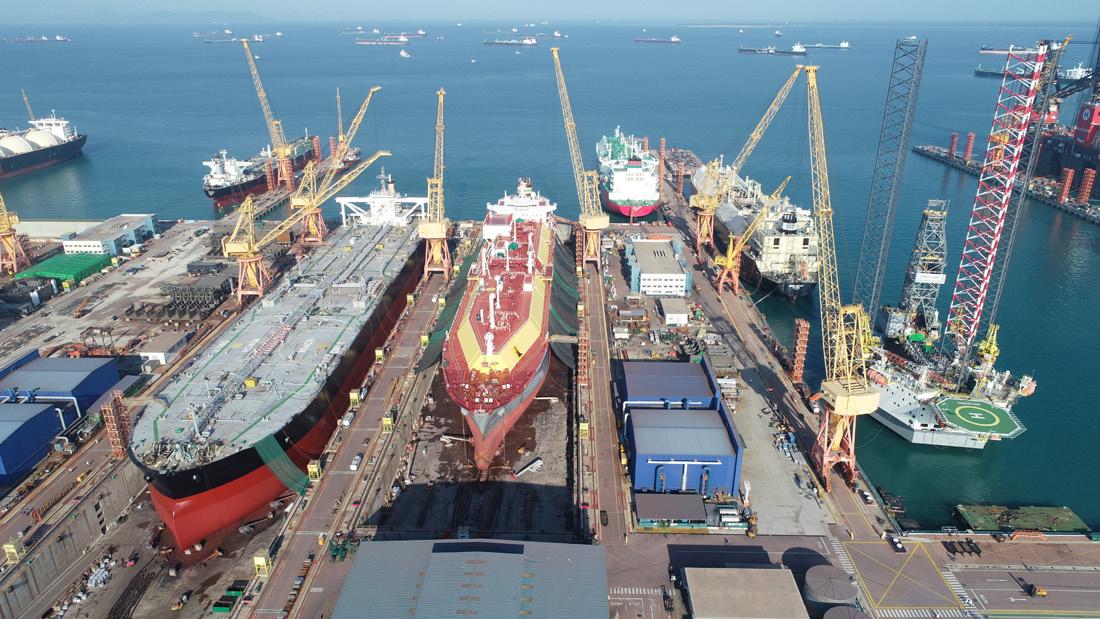Large Tankers wind down imports from there. Meanwhile, despite stunning demo prices which until May had exceeded $600/light displacement ton on the Indian subcontinent for many weeks, recycling sales have fallen right back. A typical VLCC would have yielded an end-of-life cash bonus of $25-30m at these prices. However, Clarkson recorded only 2.2m dwt of tanker tonnage heading for the beaches between January and April. There has been very little contracting either, with the last 12 months showing the lowest level of contracting since 2009 and no new crude tankers ordered during this year’s first quarter.
Safety in numbers Specialised tankers appear to be the only ‘highlight’ in recent deliveries
Torrid time for large tanker owners Owners of big tankers have been lamenting their misfortune as operating in the sector recently has meant red figures for many, just as other sectors set new records. Despite a brief recovery in April, more misery has now set it, with earnings back in loss-making territory. They have undergone major misfortune, first with the pandemic wreaking havoc on industrial demand and transport, then Putin’s invasion of Ukraine which is causing further disruption to major global oil trades. Not all analysts are on the same page, however. There are those who believe that China’s strict lockdown strategy will keep rates in the doldrums for months to come. The country’s March imports of crude shipped by sea were about nine million barrels a day, a 16% decline on the corresponding period in 2021. Tougher and extended lockdowns since March are expected to have worsened these numbers during April although this cannot be confirmed at the time of writing. Elsewhere, weak demand and high energy prices are likely to dampen oil demand more generally, they say. On the other side, Putin’s invasion of Ukraine is shifting longestablished oil trades as many countries wean themselves off Russian energy and replace crude supplies with long-haul cargoes from the Middle East and the US. Recent analysis by Clarkson Research assumed a 30% decline in Russian crude exports this year and sourcing oil from other locations was estimated to boost tonne-mile numbers by 7.3%. But the assumptions have sensitive outcomes - A greater uptake of Russian crude in Asia, for example, could limit the fall in crude exports and generate more tonne-mile growth, perhaps to 8% of more. Some analysts believe that a tanker super-cycle is likely, based on sharply higher tonnemile demand and the phasing out of large numbers of older vessels. However, there are many potential variables including, but not limited to, the course of the pandemic in key locations, especially China - the impact of high energy prices on economic activity, the scale and frequency of stock draws, possible lifting of sanctions on Iran, uncertainty in Libya, and perhaps most importantly, Putin’s future strategy in Ukraine and how the West responds. Against this uncertain and mostly serious unprofitable backdrop, it’s no surprise that most tanker owners have been biding their time. April rates returned to profitable levels for the first time in months, largely as a result of more long-haul crude shipped to Europe from the US Gulf, Middle East and West Africa. This pattern could continue for the rest of the year as more European countries seek to distance themselves from Russia and
Page 70 – www.shipandoffshorerepair.com
Scale and muscle are particularly important in the tramp trades, and major tanker owners provide a good example of the fact that size does matter. So, a possible merger between two of the sector’s largest owners is potentially a big deal. A combination of Belgium’s Euronav, currently ranked number two in fleet size, and John Frederiksen’s Frontline, number seven, would create the world’s largest tanker owner, controlling about 7% of VLCCs and 8% of the Suezmax fleet. At the time of writing, both companies’ executives were promoting the possible merger to shareholders some of whom were not convinced of the benefits and the mix of two different business cultures. The situation was further complicated by a move by Belgium’s CMB and its controlling Saverys family to combine Euronav and its decarbonisation setup, CMB Tech. Euronav directors were not keen on the move and, according to reports, embarked on a drive to assure shareholders that a tie-up with Frontline made more sense. By and large, analysts also held this view, adding independent weight to the Euronav message. Brussels investment bank, DeGroof Petercam, went public and said that the proposal would phase out Euronav’s tanker business and invest instead in ammonia and hydrogen technology and ships, according to reports. The bank said it could see little merit in the plan. There are daily developments in the merger story, and we can only provide a snapshot here. However, like other potentially high-profile transactions involving prominent shipping executives, there is probably a long way to go before the possible merger has run its course.
A combination of Belgium’s Euronav and John Frederiksen’s Frontline, would create the world’s largest tanker owner












